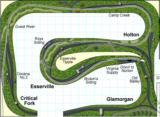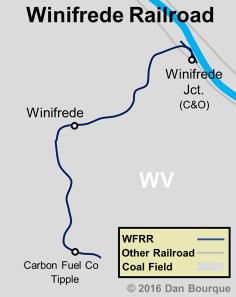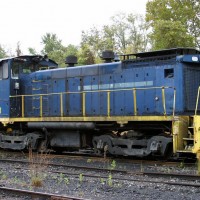Track Plans Winifrede Track Plans Winifrede Track Plans |
Photos | Models
(No Winifrede models at this time) |
History
 The first rails up Fields Creek, WV to the area’s rich coal deposits were laid before the Civil War. The narrow gauge tracks were soon abandoned, but the coal remained, and in 1881, the Winifrede Railroad was chartered to run from a connection with the Chesapeake and Ohio at Winifrede Jct, six miles up Fields Creek to the mines of the Winifrede Coal Company near the town of Winifrede, WV. While the Winifrede maintained an active interchange with the C&O, it was essentially a shuttle operation, hauling old hoppers full of coal from the company tipple to the rail-to-barge transloading facility at Winifrede Jct, on the banks of Kanawha River. The C&O provided hoppers when needed, and coal was occasionally interchanged as well.
The first rails up Fields Creek, WV to the area’s rich coal deposits were laid before the Civil War. The narrow gauge tracks were soon abandoned, but the coal remained, and in 1881, the Winifrede Railroad was chartered to run from a connection with the Chesapeake and Ohio at Winifrede Jct, six miles up Fields Creek to the mines of the Winifrede Coal Company near the town of Winifrede, WV. While the Winifrede maintained an active interchange with the C&O, it was essentially a shuttle operation, hauling old hoppers full of coal from the company tipple to the rail-to-barge transloading facility at Winifrede Jct, on the banks of Kanawha River. The C&O provided hoppers when needed, and coal was occasionally interchanged as well.
The Winifrede was a bit of an on-again, off-again operation. When years were lean and the mines shut down, the railroad sat idle, though it retained its charter. When the coal market was good, the mines and railroad came back to life. The road dieselized in 1955, purchasing a GE 70 tonner to replace an aging 2-8-0. The road again modernized in 1967 when it purchased a single new blue and gold SW1500 from EMD numbered 13 on a one-locomotive roster.

Big Eagle Railroad’s car unloader at the rail-to-barge transloading facility at Winifrede Jct., WV, Oct 2014 -Stuart Thayer
After several years of inoperation in the 1990s, a new loader was built near Winifrede, and the railroad began its shuttle service again in Aug 2000, only this time under the name of Big Eagle Rail (BER), though the Big Eagle’s SW1500 still wears its predecessor’s blue and gold and the number “13” on it’s battery box door despite it being renumbered to “01.” The BER augmented its lone switcher with a pair of leased GP38-2s still in their previous owners’ paint, JTPX 2011 is an ex-BN unit, and JTPX 2012 is an ex-UP unit. In addition to loads for the barges, the BER also interchanges strings of coal hoppers with the CSX.
Coal Operations
The Winifrede operations were simple. The switcher was kept in an engine house near Winifrede. Loads gathered at the tipple would be brought to Winifrede Jct where it appears they were backed into a small yard of stub tracks that led to the single-car unloader adjacent to the barge loader. While some cars were borrowed from the C&O and later CSX, the Winifrede owned its own small fleet of beat up old hoppers. These cars had all seen better days and weren’t even marked for interchange service. Cars were fed by gravity through the unloader and into an empty yard on the C&O interchange end of the operation. The switcher would haul strings of empties out of the empty yard and up Fields Creek to be spotted above the tipple for loading, and the cycle would begin again. The Winifrede used cabooses, but it didn’t seem to matter which end of the train they went on. Big Eagle operations appear nearly identical to the Winifrede’s operations, though with fewer tracks at the new loader, switching at the loader isn’t as tedious.
References:
Huddleston, Gene. C&O Coal and Color. C&O Historical Society. 1997.
U.S. Railroad Retirement Board. “Employer Status Determination – Big Eagle Rail, LLC”.
Wikipedia. “ICC Valuations – Winifrede Railroad”.
WV Rails. “Two Short Lines of the Kanawha Valley”.
Related Products:







